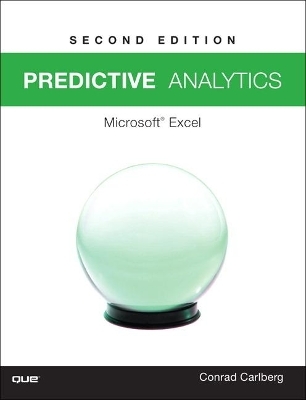
Predictive Analytics
Que Corporation (Verlag)
978-0-7897-5835-4 (ISBN)
- The revised complete guide to state-of-the-art predictive analytics with the newest version of the tool that everyone has: Excel!
- Demystifies advanced techniques and helps readers apply them to real business problems, from sales and marketing to operations
- Provides hands-on learning with Excel spreadsheets
Excel predictive analytics for serious data crunchers!
The movie Moneyball made predictive analytics famous: Now you can apply the same techniques to help your business win. You don't need multimillion-dollar software: All the tools you need are available in Microsoft Excel, and all the knowledge and skills are right here, in this book!
Microsoft Excel MVP Conrad Carlberg shows you how to use Excel predictive analytics to solve real-world problems in areas ranging from sales and marketing to operations. Carlberg offers unprecedented insight into building powerful, credible, and reliable forecasts, showing how to gain deep insights from Excel that would be difficult to uncover with costly tools such as SAS or SPSS.
You'll get an extensive collection of downloadable Excel workbooks you can easily adapt to your own unique requirements, plus VBA code-much of it open-source-to streamline several of this book's most complex techniques. Step by step, you'll build on Excel skills you already have, learning advanced techniques that can help you increase revenue, reduce costs, and improve productivity.
By mastering predictive analytics, you'll gain a powerful competitive advantage for your company and yourself. * Learn both the "how" and "why" of using data to make better tactical decisions
* Choose the right analytics technique for each problem
* Use Excel to capture live real-time data from diverse sources, including third-party websites
* Use logistic regression to predict behaviors such as "will buy" versus "won't buy"
* Distinguish random data bounces from real, fundamental changes
* Forecast time series with smoothing and regression
* Construct more accurate predictions by using Solver to find maximum likelihood estimates
* Manage huge numbers of variables and enormous datasets with principal components analysis and Varimax factor rotation
* Apply ARIMA (Box-Jenkins) techniques to build better forecasts and understand their meaning
Conrad Carlberg is a nationally recognized expert on quantitative analysis and on data analysis and management applications such as Microsoft Excel, SAS and Oracle. He holds a Ph.D. in statistics from the University of Colorado and is a many-time recipient of Microsoft's Excel MVP designation. Carlberg is a Southern California native. After college he moved to Colorado, where he worked for a succession of startups and attended graduate school. He spent two years in the Middle East, teaching computer science and dodging surly camels. After finishing graduate school, Carlberg worked at US West (a Baby Bell) in product management and at Motorola. In 1995 he started a small consulting business which provides design and analysis services to companies that want to guide their business decisions by means of quantitative analysis — approaches that today we group under the term "analytics." He enjoys writing about those techniques and, in particular, how to carry them out using the world's most popular numeric analysis application, Microsoft Excel.
Introduction to the 2013 Edition ....................... 1
You, Analytics, and Excel .....................................2
Excel as a Platform .......4
What’s in This Book ......4
Introduction to this Edition ............................... 7
Inside the Black Box .....8
Helping Out Your Colleagues ..............................8
1 Building a Collector .....................................11
Planning an Approach .....................................12
A Meaningful Variable ...............................12
Identifying Sales ..13
Planning the Workbook Structure ....................13
Query Sheets .......13
Summary Sheets .18
Snapshot Formulas ....................................20
Customizing Your Formulas ........................21
The VBA Code .............23
The DoItAgain Subroutine ...................24
The DontRepeat Subroutine ................25
The PrepForAgain Subroutine ...........25
The GetNewData Subroutine ................26
The GetRank Function............................30
The RefreshSheets Subroutine .......32
The Analysis Sheets....33
Defining a Dynamic Range Name ..............34
Using the Dynamic Range Name ...............36
2 Linear Regression .......................................39
Correlation and Regression .............................39
Charting the Relationship .........................40
Calculating Pearson’s Correlation Coefficient ......................................43
Correlation Is Not Causation .............................45
Simple Regression .....46
Array-Entering Formulas ...........................48
Array-Entering LINEST( ) ..........................49
Multiple Regression ..49
Creating the Composite Variable ..............50
Entering LINEST( ) with Multiple Predictors .......................................51
Merging the Predictors .............................51
Analyzing the Composite Variable ............53
Assumptions Made in Regression Analysis ......54
Variability ...........55
Measures of Variability: Bartlett’s Test of Homogeneity of Variance ...57
Means of Residuals Are Zero .....................58
Normally Distributed Forecasts .................59
Using Excel’s Regression Tool ...........................59
Accessing the Data Analysis Add-ln ..........59
Accessing an Installed Add-ln ...................60
Running the Regression Tool .....................61
Understanding the Regression Tool’s Dialog Box ................................62
Understanding the Regression Tool’s Output .....................................64
3 Forecasting with Moving Averages ..............71
About Moving Averages ..................................71
Signal and Noise .72
Smoothing Out the Noise .........................73
Lost Periods ........74
Smoothing Versus Tracking .......................74
Weighted and Unweighted Moving Averages ....................................76
Total of Weights ..77
Relative Size of Weights ............................78
More Recent Weights Are Larger ...............78
Criteria for Judging Moving Averages .............80
Mean Absolute Deviation ..........................80
Least Squares ......80
Using Least Squares to Compare Moving Averages .............................81
Getting Moving Averages Automatically .........82
Using the Moving Average Tool .................83
Labels .................85
Output Range .....85
Actuals and Forecasts ................................85
Interpreting the Standard Errors–Or Failing to Do So .......................87
4 Forecasting a Time Series: Smoothing ..........89
Exponential Smoothing: The Basic Idea............90
Why “Exponential” Smoothing? .......................92
Using Excel’s Exponential Smoothing Tool ........95
Understanding the Exponential Smoothing Dialog Box ......................96
Choosing the Smoothing Constant ................102
Setting Up the Analysis ...........................103
Using Solver to Find the Best Smoothing Constant ...........................105
Understanding Solver’s Requirements .....110
The Point ...........113
Handling Linear Baselines with Trend ............114
Characteristics of Trend ............................114
First Differencing .....................................117
5 More Advanced Smoothing Models ............123
Holt’s Linear Exponential Smoothing .............123
About Terminology and Symbols in Handling Trended Series ...........124
Using Holt’s Linear Smoothing .................124
Holt’s Method and First Differences .........130
Seasonal Models ......133
Estimating Seasonal Indexes ...................134
Estimating the Series Level and First Forecast ..................................135
Extending the Forecasts to Future Periods ........................................136
Finishing the One-Step-Ahead Forecasts .137
Extending the Forecast Horizon ...............138
Using Additive Holt-Winters Models ..............140
Level ..................143
Trend .................143
Season ...............144
Formulas for the Holt-Winters Additive and Multiplicative Models.........145
Formulas for the Additive Model .............146
Formulas for the Multiplicative Model .....148
The Models Compared ...................................149
Damped Trend Forecasts ................................151
6 Forecasting a Time Series: Regression ........153
Forecasting with Regression ..........................153
Linear Regression: An Example ................155
Using the LINEST( ) Function ...................158
Forecasting with Autoregression....................164
Problems with Trends ..............................164
Correlating at Increasing Lags ..................165
A Review: Linear Regression and Autoregression ..............................168
Adjusting the Autocorrelation Formula ....169
Using ACFs .........171
Understanding PACFs ...............................172
Using the ARIMA Workbook .....................178
7 Logistic Regression: The Basics...................181
Traditional Approaches to the Analysis ..........181
Z-tests and the Central Limit Theorem .....181
Sample Size and Observed Rate ...............183
Binomial Distribution ..............................183
Only One Comparison ..............................184
Using Chi-Square .....................................185
Preferring Chi-Square to a Z-test .............187
Regression Analysis on Dichotomies .............191
Homoscedasticity ....................................191
Residuals Are Normally Distributed ........194
Restriction of Predicted Range ................194
Ah, But You Can Get Odds Forever .................195
Probabilities and Odds .............................195
How the Probabilities Shift .....................197
Moving On to the Log Odds ....................200
8 Logistic Regression: Further Issues .............203
An Example: Predicting Purchase Behavior ....204
Using Logistic Regression ........................205
Calculation of Logit or Log Odds ..............213
Comparing Excel with R: A Demonstration .....228
Getting R ...........229
Running a Logistic Analysis in R ..............229
Importing a csv File into R .......................230
Importing From an Open Workbook Into R .......................................233
Understanding the Long Versus Wide Shape ....................................234
Running Logistic Regression Using glm ...235
Statistical Tests in Logistic Regression ............240
Models Comparison in Multiple Regression ......................................240
Calculating the Results of Different Models ......................................241
Testing the Difference Between the Models .....................................242
Models Comparison in Logistic Regression .......................................243
9 Multinomial Logistic Regression ................253
The Multinomial Problem ..............................253
Three Alternatives and Three Predictors .........254
Three Intercepts and Three Sets of Coefficients .................................256
Dummy Coding to Represent the Outcome Value .............................256
Calculating the Logits ..............................256
Converting the Logits to Probabilities ......257
Calculating the Log Likelihoods ...............258
Understanding the Differences Between the Binomial and Multinomial Equations ...............258
Optimizing the Equations ........................260
Benchmarking the Excel Results Against R ....261
Converting the Raw Data Frame with mlogit.data ...................262
Calling the mlogit Function .................264
Completing the mlogit Arguments ......266
Four Outcomes and One Predictor ..................267
Multinomial Analysis with an Individual-Specific Predictor ..............269
Multinomial Analysis with an Alternative-Specific Predictor ............272
10 Principal Components Analysis ..................275
The Notion of a Principal Component ............275
Reducing Complexity ...............................276
Understanding Relationships Among Measurable Variables .............277
Maximizing Variance................................278
Components Are Mutually Orthogonal ....280
Using the Principal Components Add-In ........281
The R Matrix ......284
The Inverse of the R Matrix ......................284
Matrices, Matrix Inverses, and Identity Matrices ...............................287
Features of the Correlation Matrix’s Inverse ......................................288
Matrix Inverses and Beta Coefficients ......290
Singular Matrices .....................................293
Testing for Uncorrelated Variables ...........293
Using Eigenvalues ....................................295
Using Component Eigenvectors ...............296
Factor Loadings .299
Factor Score Coefficients ..........................299
Principal Components Distinguished from Factor Analysis ......................303
Distinguishing the Purposes ....................303
Distinguishing Unique from Shared Variance ....................................303
Rotating Axes ....305
11 Box-Jenkins ARIMA Models ........................307
The Rationale for ARIMA ................................307
Deciding to Use ARIMA ............................308
ARIMA Notation .308
Stages in ARIMA Analysis ...............................310
The Identification Stage .................................310
Identifying an AR Process ........................310
Identifying an MA Process .......................313
Differencing in ARIMA Analysis ................315
Using the ARIMA Workbook .....................320
Standard Errors in Correlograms ..............321
White Noise and Diagnostic Checking......322
Identifying Seasonal Models ....................323
The Estimation Stage .....................................324
Estimating the Parameters for ARIMA(1,0,0) ....................................324
Comparing Excel’s Results to R’s ...............326
Exponential Smoothing and ARIMA(0,0,1) .......................................329
Using ARIMA(0,1,1) in Place of ARIMA(0,0,1) ...................................332
The Diagnostic and Forecasting Stages ..........333
12 Varimax Factor Rotation in Excel ................335
Getting to a Simple Structure .......................335
Rotating Factors: The Rationale ...............336
Extraction and Rotation: An Example ......339
Structure of Principal Components and Factors ......................................344
Rotating Factors: The Results ..................345
Charting Records on Rotated Factors ......348
Using the Factor Workbook to Rotate Components ..........................350
| Erscheinungsdatum | 12.08.2017 |
|---|---|
| Sprache | englisch |
| Maße | 178 x 232 mm |
| Gewicht | 612 g |
| Einbandart | kartoniert |
| Themenwelt | Informatik ► Datenbanken ► Data Warehouse / Data Mining |
| Informatik ► Office Programme ► Excel | |
| Informatik ► Office Programme ► Outlook | |
| Mathematik / Informatik ► Mathematik ► Finanz- / Wirtschaftsmathematik | |
| Wirtschaft ► Betriebswirtschaft / Management ► Unternehmensführung / Management | |
| Wirtschaft ► Volkswirtschaftslehre ► Ökonometrie | |
| Schlagworte | Data Analysis • Datenanalyse • Excel • Predictive Analysis • Statistik |
| ISBN-10 | 0-7897-5835-0 / 0789758350 |
| ISBN-13 | 978-0-7897-5835-4 / 9780789758354 |
| Zustand | Neuware |
| Informationen gemäß Produktsicherheitsverordnung (GPSR) | |
| Haben Sie eine Frage zum Produkt? |
aus dem Bereich


